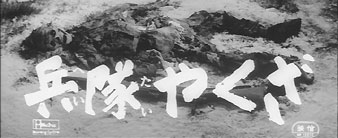
Did director Yasuzo Masumura have a personal interest in s & m or did he simply find it metaphorical for the Japanese psyche? Moju (Blind Beast), based on an Edogawa Rampo story, was a cinematic treatise on sado-masochistic desire and its ramifications. Heitai Yakuza (Hoodlum Soldier) (1965) examines Japanese social hierarchy and its s & m leanings through a story of a yakuza serving in the Japanese army, stationed in Manchuria. The yakuza (played by Zatoichi himself, Katsu Shintaro) ends up being a punching bag for almost every senior officer, all who seem to have some kind of chip on their soldier. Because of rank he's not allowed to hit back. But you know that won't last for too long. It must be tough growing up in a country where you always have to answer to someone; where concepts of seniority and superiority are so ingrained in everyday life, from family to school to the workplace and so on, that the subconcious is built for abuse or to dish it out if the chance arises. The screenplay allows Masumura to question this behavior, seemingly di rigeur for the society as a whole (imagine CEOs verbally lambasting sallarymen and senpai - kohai ijime). A subversive voice emerges through the relationship between the yakuza and an idealistic conscientious objector officer that befriends and protects him. There are Lots of beatings and fights, because the yakuza naturally is a real scrapper and takes on several men at the same time. Quite compelling and it spawned several sequels. We can thank Ian Buruma for selecting it for Asia Society's yakuza film series, which you can read more about in my article here. The whole idea of getting beaten on and then fighting back reminds me of that 70's kung fu trailer that had the tag line "he takes a licking and keeps on kicking." And I think the voice over artist on that was Adolph Caeser.










